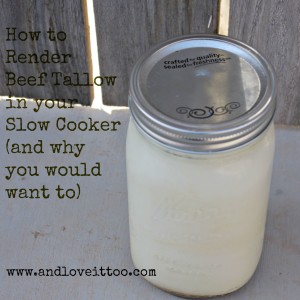
First, some of you may be asking, “what is beef tallow?”
To put it simply, beef tallow is rendered beef fat.
Grass fed beef tallow is rich in niacin, vitamins B6, B12, K2, selenium, iron, phosphorus, potassium and riboflavin. Grass fed beef tallow also contains a high ratio of CLA which is known to be a cancer-resistant agent. According to Nourishing Traditions, studies have shown that human beings need at least 50% of saturated fats like tallow and lard to keep the heart pumping well and healthy.
Beyond all of that beef tallow is, quite literally, the best anti-stick oil I have ever used. That, and it tastes ah-mazing!
Unless you are raising your own cattle, the best place to obtain the suet you need to render beef tallow from is to simply ask your local grass-fed beef rancher. Don’t even think about using the stuff you’ll find at the store…fat is where a majority of toxins are stored in the system, it is vital to obtain this fat from someone you trust and cows you know were raised well.
Good quality grass-fed beef tallow sells for well over $1 an ounce. From 5 pounds of suet, I was able to obtain almost a gallon of tallow (about 128 ounces), well worth the money I paid.
What you need:
- Good quality beef fat. You can render any beef fat into tallow, but the best is the fat from around the kidneys of the animal, the ‘leaf fat’, if you can get that, you’re gold.
- A large slow cooker (6 or 7 qt is best)
- Clean wide mouth glass jars for storage
- A sieve and cheesecloth
- A canning funnel
Beef fat is easiest to work with when it is cold. I recommend refrigerating fat overnight to make it easier to cut.
When ready, chop the fat into chunks, approximately 1-2 inch cubes. Be certain to trim off bits of meat, blood, gristle or anything else you may find.

Once everything is trimmed, run the fat through the food processor. You can see that my fat was starting to get warm here, I should have re-refrigerated it, but hind sight is 20/20. 🙂 If you don’t have a food processor, simply chop the fat into smaller pieces, shredding simply makes the rendering process go much faster.
Once shredded, dump the fat into your slowcooker and begin melting on very low heat for 6-8 hours.
Check the fat occasionally and give it a stir to prevent burning.

As the fat renders you will notice that the impurities will rise to the top. It is finished when there is clear liquid at the bottom and the impurities become crispy, floating on the top.
Strain the tallow through a cheesecloth lined sieve layered over your canning funnel, into your clean wide mouth jar.

Tallow can be stored in the pantry, although I refrigerate mine which helps to extend the shelf life. You can even freeze it for longer storage.
Use your tallow for everything…frying, candles, soap.
With this you can officially brag to all of your DIY friends, “I rendered my own beef tallow last night.” 😉















Speak Your Mind